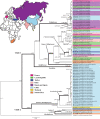Review on the molecular study of the Diplozoidae: analyses of currently available genetic data, what it tells us, and where to go from here
- PMID: 33126913
- PMCID: PMC7602351
- DOI: 10.1186/s13071-020-04417-3
Review on the molecular study of the Diplozoidae: analyses of currently available genetic data, what it tells us, and where to go from here
Abstract
The use of molecular tools in the study of parasite taxonomy and systematics have become a substantial and crucial component of parasitology. Having genetic characterisation at the disposal of researchers has produced mostly useful, and arguably more objective conclusions. However, there are several groups for which limited genetic information is available and, coupled with the lack of standardised protocols, renders molecular study of these groups challenging. The Diplozoidae are fascinating and unique monogeneans parasitizing mainly freshwater cyprinid fishes in Europe, Asia and Africa. This group was studied from a molecular aspect since the turn of the century and as such, limitations and variability concerning the use of these techniques have not been clearly defined. In this review, all literature and molecular information, primarily from online databases such as GenBank, were compiled and scrupulously analysed for the Diplozoidae. This was done to review the information, detect possible pitfalls, and provide a "checkpoint" for future molecular studies of the family. Hindrances detected are the availability of sequence data for only a limited number of species, frequently limited to a single sequence per species, and the heavy reliance on one non-coding ribosomal marker (ITS2 rDNA) which is difficult to align objectively and displays massive divergences between taxa. Challenging species identification and limited understanding of diplozoid species diversity and plasticity are also likely restricting factors, all of which hamper the accurate taxonomic and phylogenetic study of this group. Thus, a more integrated taxonomic approach through the inclusion of additional markers, application of more rigorous morphological assessment, more structured barcoding techniques, alongside thorough capturing of species descriptions including genetypes, genophore vouchers and reference collections in open sources are encouraged. The pitfalls highlighted are not singular to the Diplozoidae, and the study of other groups may benefit from the points raised here as well.
Keywords: Afrodiplozoon; Diplozoon; Eudiplozoon; Fish parasites; Genetic characterisation; Inustiatus; Molecular taxonomy; Monogenea; Paradiplozoon; Sindiplozoon.
Conflict of interest statement
Not applicable.
Figures


Similar articles
-
Paradiplozoon cirrhini n. sp. (Monogenea, Diplozoidae), a gill parasite of Cirrhinus molitorella (Cyprinidae, Labeoninae) in South China.Parasite. 2023;30:20. doi: 10.1051/parasite/2023022. Epub 2023 Jun 6. Parasite. 2023. PMID: 37285125 Free PMC article.
-
Redescription of the genus Afrodiplozoon Khotenovski, 1981 and its only known species Afrodiplozoon polycotyleus (Paperna, 1973) (Monogenea: Diplozoidae) using a combined multidisciplinary approach.Parasitol Int. 2018 Apr;67(2):245-252. doi: 10.1016/j.parint.2017.11.008. Epub 2017 Nov 29. Parasitol Int. 2018. PMID: 29197595
-
Genetic characterization of six species of diplozoids (Monogenea; Diplozoidae).Parasitology. 2001 Nov;123(Pt 5):465-74. doi: 10.1017/s0031182001008617. Parasitology. 2001. PMID: 11719957
-
[Fauna of monogeneans (Monogenea, Platyhelminthes) of gudgeons (Gobioninae, Cyprinidae). 1. Composition, structure, and characteristics of distribution].Parazitologiia. 2008 Sep-Oct;42(5):405-27. Parazitologiia. 2008. PMID: 19065839 Review. Russian.
-
A review of molecular identification tools for the opisthorchioidea.J Microbiol Methods. 2021 Aug;187:106258. doi: 10.1016/j.mimet.2021.106258. Epub 2021 Jun 1. J Microbiol Methods. 2021. PMID: 34082051 Review.
Cited by
-
Revisiting the type material of two African Diplozoinae (Diplozoidae: Monogenea), with remarks on morphology, systematics and diplozoid specificity.PeerJ. 2024 Feb 28;12:e17020. doi: 10.7717/peerj.17020. eCollection 2024. PeerJ. 2024. PMID: 38435989 Free PMC article.
-
Diversity, phylogeny and intraspecific variability of Paradiplozoon species (Monogenea: Diplozoidae) parasitizing endemic cyprinoids in the Middle East.Parasitology. 2023 Jul;150(8):705-722. doi: 10.1017/S0031182023000446. Epub 2023 May 9. Parasitology. 2023. PMID: 37157105 Free PMC article.
-
Uncovering the monogenean species diversity of cyprinoid fish in Iraq using an integrative approach.Parasitology. 2024 Feb;151(2):220-246. doi: 10.1017/S0031182023001348. Epub 2023 Dec 20. Parasitology. 2024. PMID: 38116665 Free PMC article.
-
The complete mitochondrial genomes of Paradiplozoon yarkandense and Paradiplozoon homoion confirm that Diplozoidae evolve at an elevated rate.Parasit Vectors. 2022 Apr 27;15(1):149. doi: 10.1186/s13071-022-05275-x. Parasit Vectors. 2022. PMID: 35477556 Free PMC article.
-
Paradiplozoon cirrhini n. sp. (Monogenea, Diplozoidae), a gill parasite of Cirrhinus molitorella (Cyprinidae, Labeoninae) in South China.Parasite. 2023;30:20. doi: 10.1051/parasite/2023022. Epub 2023 Jun 6. Parasite. 2023. PMID: 37285125 Free PMC article.
References
-
- Anderson RM. An analysis of the influence of host morphometric features on the population dynamics of Diplozoon paradoxum (Nordmann, 1832) J Anim Ecol. 1974;43:873–887. doi: 10.2307/3541. - DOI
-
- Gläser HJ, Gläser B. Zur Taxonomie von Diplozoon Normann, 1832. Zeitschr Parasitenkd. 1964;25:164–192. - PubMed
-
- Khotenovsky IA. Suborder Octomacrinea Khotenovsky. In: Scarlato OA, editor. Fauna of the USSR. Monogenea. Moscow: Russian Academy of Sciences, Zoological Institute; 1985.
-
- Thomas JD. A new monogenetic Trematode, Diplozoon ghanense, sp. nov. (Polyopisthocotylea: Discocotylea) from the West African freshwater fish Alestes macrolepidotus (C. & V., 1849), in West Africa. J West Afr Sci Assoc. 1957;1957(3):178–182.
Publication types
MeSH terms
Substances
Grants and funding
LinkOut - more resources
Full Text Sources

